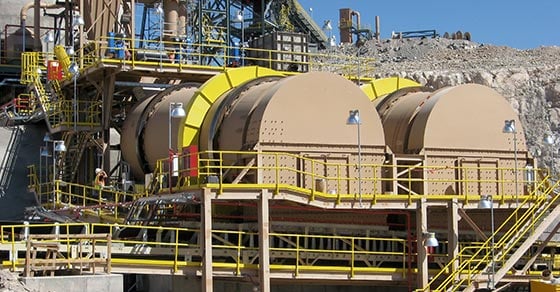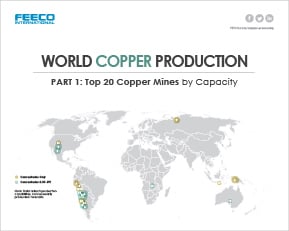Copper is an essential component in many of the products that make up the world around us. Ductility, malleability, and superior conductivity of heat and electricity, are just a few of the properties that make this unique metal so useful across a broad range of applications.
According to the International Copper Study Group’s (ICSG) annual World Copper Factbook, use of refined copper hit 25 million tons in 2020 (up from 19.1 in just 2017).¹
Provided here is an overview on the current copper industry, including common and emerging uses of copper, where copper is produced, who is producing it, refinement techniques, and what other materials are being produced alongside copper.
Copper Uses
Copper is a key component in many of the products that keep our world running. Among many others, some of the products that rely on copper include:
- Alloys (Bronze, Brass)
- Wiring and cables for power, data, and signal transmission
- Piping and Plumbing
- Electronics
- Electric Motors
- Building Materials
- And many, many more…
And while copper has an array of well developed applications, its valuable combination of physical and chemical properties have continued to make it the subject of research and development. The Copper Alliance recognizes a diverse range of emerging applications for copper. Among them:
- Renewable Energy
- Aquaculture
- Antimicrobial Surfaces
- Electrical Propulsion
- Seismic Energy Dissipation
Most recently, copper has been receiving attention for the role it will play in reaching a low-carbon economy, particularly when it comes to electric vehicles (EVs). Its role as an antimicrobial has also seen growing interest, courtesy of the ongoing coronavirus pandemic. The “smart city” trend is also pushing demand for the metal.
Where Copper is Produced
Global production of copper for 2020 was 20.6 million tons. While copper is produced around the globe, production is largely localized to select regions, specifically Latin America; in 2020, Latin America accounted for 41% of global copper mine production. Asia was the second largest producer at 16%, followed by Europe with 14%, North America and Africa at 12% each, and Oceania with 5%. Peru has also been making steady gains in production since 2015, accounting for 10% of production in 2020.¹
Top 20 Copper Mines
ICSG also ranked the top 20 copper mines by production capabilities for 2021:
- Escondida (Chile)
- Grasberg (Indonesia)
- Collahuasi (Chile)
- Buenavista del Cobre (Mexico)
- Morenci (USA)
- Cerro Verde II (Peru)
7-8.Polar Division (Russia), Antamina (Peru)
- Las Bambas (Peru)
- El Teniente (Chile)
- Los Pelambres (Chile)
- Chuquicamata (Chile)
- Cobre Panama (Panama)
Los Bronces (Chile), Kansanshi (Zambia), and Radomiro Tomic (Chile) came in at 14th – 16th with equal capacity, followed by Kamoto (Congo), Sentinel (Zambia), and Toromocho (Peru) at 17th – 19th with equal capacity. Bingham Canyon (USA) rounded out the list in 20th position.
Click on the image below to view the infographic showcasing the top 20 copper mines by production capabilities, along with the owners and what other materials these sites produce.
Major Copper Producers
Not unlike other metals, the copper industry is comprised of several industry magnates. Investing News reported on data from Refinitiv, which ranked the top ten copper producers according to 2020 production numbers. In order, they are:
- Codelco
- Glencore
- BHP
- Freeport-McMoRan
- Grupo Mexico
- First Quantum Minerals
- Rio Tinto
- KGHM Polska Miedz
- Antofagasta
- Norilsk Nickel
Copper Refining Methods
Once mined, copper ore goes through a series of processing stages in order to refine it into a saleable copper product. Copper can be refined by one of two approaches: pyrometallurgy or hydrometallurgy.
Pyrometallurgical Copper Refining
The pyrometallurgical approach, often referred to as smelting, is the primary method used for refining copper. In this process, used for sulphide ores, copper concentrates are thermally treated in a smelter and then refined into a pure copper product.
Of the top 20 copper mines listed by ICSG, half produced copper by the pyrometallurgical approach alone.
Hydrometallurgical Copper Refining
The hydrometallurcial approach to refining copper ore is known as solvent extraction electro-winning (SX-EW), or leach solvent extraction electro-winning (L-SX-EW) for its convergence with the heap leaching technique.
SX-EW is a series of steps whereby ore is heap leached to obtain a pregnant solution, then combined with an extractant/reagent in order to produce an electrolytic-bearing copper solution from which copper can be electrowon.
SX-EW has become a critical tool in the copper industry, as it can be used where smelting is not an economically feasible option, namely to process oxide and low-grade sulphide ores.
Of the top 20 mines, half incorporated SX-EW into their operations. One mine, Kamoto, produced copper by SX-EW alone.
See our infographic to learn more about these two copper refining techniques >>
Materials Produced Alongside Copper
It is not uncommon for copper mines to process additional metals at their facilities. Many copper mines also produce gold, silver, and/or molybdenum, and less commonly, may also produce platinum group metals, nickel, zinc, and even uranium.
Conclusion
Copper’s unique combination of properties lend it to a diverse range of applications. The production of copper is just as diverse as its uses, with mines scattered all over the globe and several industry magnates accounting for production. The two refinement techniques – copper smelting and SX-EW – allow both traditional ore sources as well as oxide and low-grade sulphide ores to be processed, with many materials often produced alongside copper.
FEECO provides heavy-duty pugmill mixers (paddle mixers) for use in the copper smelting process, as well as agglomerators (ore drums) for use in the heap leaching/SX-EW process. Some of the world’s largest and most environmentally advanced copper mines rely on FEECO for the best in process equipment. For more information, contact us today!



